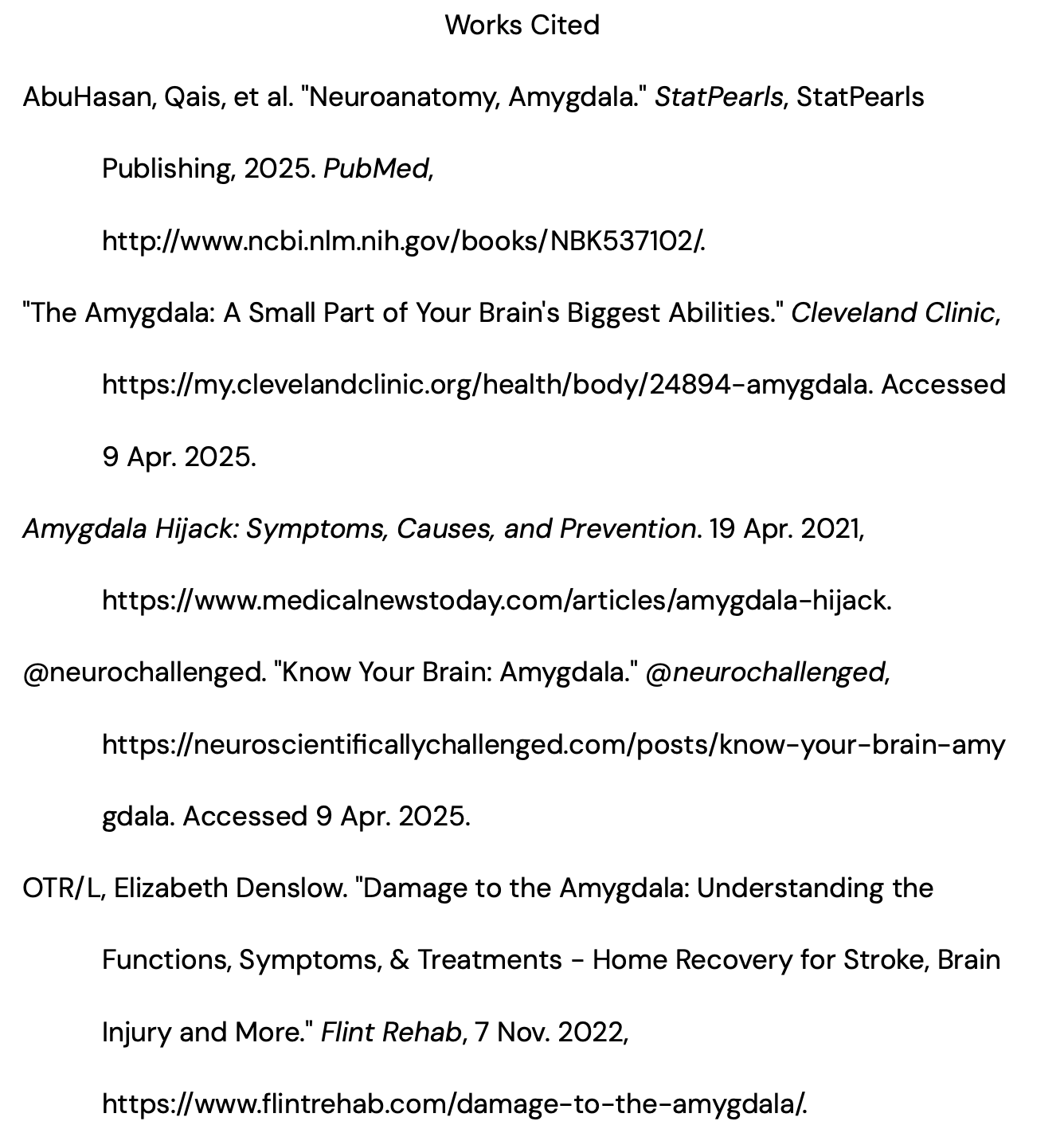The Amygdala
Abstract
Research on the amygdala has uncovered its vast purposes and complex properties. Its ties to emotions and fear responses have been the primary subject of these studies, but the amygdala plays a role in many different functions and coordinates with several different brain regions. Experiments with humans and mice have been conducted to test such functions, and the findings have greatly advanced our understanding of the structure and paved the way for future studies. Some of the neurological categories that involve the amygdala include emotions, memory, and learning. That being said, when the amygdala faces harm, there are a plethora of consequences, including neurological disorders and mental health conditions. Many harmful causes and symptoms have been identified as being related to amygdala impairment, and various conditions are associated with it. However, there are some remarkable tidbits to be noted about the amygdala that provide further insights into this incredible part of the brain.
Introduction
The amygdala is a part of the brain that is involved in the limbic system (AbuHasan et al.). It is structurally a small pair of almond-shaped parts located in the temporal lobe, near the hippocampus (“Amygdala Hijack”). To paraphrase an article from the Cleveland Clinic, the amygdala is primarily made up of neurons and glial cells. Neurons are the most well-known specialized cells of the nervous system, and are responsible for transmitting chemical and electrical signals throughout the brain and body. They bundle together to create nuclei, and the amygdala contains 13 such nuclei. Glial cells, on the other hand, are the neurons’ designated support cells. Examples include astrocytes, which maintain the blood-brain barrier, and oligodendrocytes, which build myelin sheaths (“The Amygdala”).
Functions
As explained by an article from the National Library of Medicine, the amygdala, while small in size, is responsible for a variety of essential physiological functions. The most simple description of its function is emotional processing. Specifically, it’s associated with fear and fear conditioning/mediation, meaning it uses past experience to produce the appropriate response to a fear-inducing stimulus (AbuHassan et al.).
Experiments have shown that when the human amygdala is electrically stimulated, it produces a fear response. For instance, it allows us to learn to be afraid of and actively or passively avoid harmful situations (like putting your hand on a hot stove) through fear conditioning. But aside from just programming for adverse scenarios, the amygdala also conditions us to desire stimuli such as food, sex, and drugs. Additionally, it’s related to anxiety and aggression, as well as emotional memory (“Know Your Brain”).
To go more in detail, the amygdala triggers a “fight or flight” response when it senses a frightening stimulus. This can raise breathing and heart rate as the body decides whether to confront the stimulus or try to avoid it. It allows us to respond reflexively without thinking, such as by jumping back when we see a snake. Moreover, it stores fear-producing events by creating emotionally charged memories about them. For example, if you expose a mouse to an electric shock after playing a certain sound, it will begin associating that sound with the painful shock and start displaying a fear reaction every time they hear it (“Know Your Brain”).
Some of the higher cognitive functions it contributes to include learning and making decisions (Denslow). In terms of learning, the amygdala contributes to interpreting rewards and punishments to understand concepts, kind of like when you reward a dog with a treat for sitting on command and thus it is trained to start doing that. Overall, the amygdala dabbles with many different functions, making it a versatile and vital part of the brain.
Problems With the Amygdala
Like any other parts of the brain, issues regarding the amygdala can have serious consequences. Traumatic brain injuries, stroke, seizure, temporal lobe epilepsy, and Alzheimer’s disease are all common causes of amygdala impairment (Denslow). Regarding Alzheimer’s specifically, it’s been posited that the memory loss that characterizes the condition is a result of neurons in the amygdala dying (“Know Your Brain”). Potential signs of amygdala damage include anxiety disorders, such as post-traumatic stress disorder, obsessive-compulsive disorder, and frequent panic attacks (Wendt). Additionally, memory problems can be an effect of amygdala issues, because memory loss occurs when the amygdala and hippocampus don’t function together properly (“Know Your Brain”). Damage is also associated with hypervigilance and decision-making problems (Denslow).
One lesser known neurological disorder related with amygdala damage is Kluver-Bucy Syndrome, which involves symptoms like hyperorality, placidity, and insatiable appetite (“Know Your Brain”). Aside from that, brain cancer and Autism Spectrum Disorder have also shown to be caused at least in part by impairment of this structure (“The Amygdala”). The wide range of health conditions impacted by the amygdala just goes to show how integral it is to the brain, and the variety of purposes it aids in.
Lastly, a phenomenon known as amygdala hijack can be potentially harmful, as it describes the situation in which the amygdala causes a person to overreact to a stimulus, meaning they can’t think clearly about what is happening and typically respond in a way that is out of proportion (“Amygdala Hijack”). The name represents how an overwhelmed amygdala literally “hijacks” the rational parts of the brain, releasing cortisol and adrenaline to promote that “fight or flight” response (Denslow). To prevent this from happening, taking a breather and evaluating your stressor can reduce risk of amygdala hijack (“Amygdala Hijack”).
Additional Information and Fun Facts
“Amygdala “actually translates to almond! (Wendt)
You can survive with just 1 of the paired structure (“7 Amazing Facts”)
MRI, PET, EEG, and MEG scans are commonly used to test the amygdala for malfunctions (“The Amygdala”)
The reflex to “jump” when startled is an everyday function of the fight-or-flight response (Wendt)
Mindfulness practices such as meditation can help lessen the effects of amygdala impairment, such as anxiety (“Know Your Brain”)
The location of the amygdala makes it difficult to study, but researchers hope to uncover more about it’s purposes (“7 Amazing Facts”)


